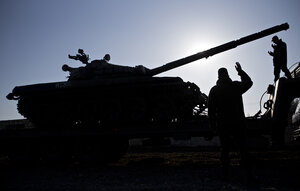Russia debuts new, sleek force in Crimea, rattling NATO
But while the Russian Army's latest showing was far better than its blundering in Georgia in 2008, Crimea offered advantages that the Kremlin is unlikely to see elsewhere.

Russian officers gesture to the driver of Russian tank T-72B at the Ostryakovo railway station near Simferopol, Crimea, on Monday.
Pavel Golovkin/AP
Moscow
The last time the Russian military machine was on public display in Europe, its performance did not impress. But this is no longer the force that NATO observed blundering its way through a brief but messy war with its tiny neighbor, Georgia, back in 2008.
A new, leaner and meaner Russian Army has been on display in Crimea and war-gaming on the Ukrainian border over the past month or so. Its vanguard is now made up of just a few elite divisions of highly-motivated, well trained, and fully equipped volunteer soldiers, capable of deploying swiftly anywhere in the former Soviet Union on the Kremlin's command.
And that fact is raising alarms about the potential for wider Kremlin aggression that haven't been heard in the West since the end of the cold war.
Since it last went into action in 2008, the Russian military has seen huge funding increases and undergone radical reforms that have stripped it down, reorganized it, and professionalized it. Though the old Soviet-era model of a "mass mobilization" army still exists on paper, radical Kremlin-backed changes have effectively abolished about 80 percent of former military units, furloughed tens of thousands of officers, and doubled the pay for those who remained.
"At the end of the day, Russia will have between 50,000 and 80,000 of these highly mobile, professional forces, which will make it the most effective army in our region," albeit one that's not a plausible threat to NATO, says Alexander Golts, a leading independent military expert. "This process has been moving very rapidly."
Crimea's lesson...
As the Ukrainian crisis unfolded over the past month, Russia's military staged unprecedented maneuvers all along the Ukrainian frontier that experts say showed a new level of speed, agility, and tactical integration among the different branches of the armed forces. In early March, Russian special forces surprised observers again by mounting a lighting fast operation that effectively seized the Crimean peninsula, virtually without casualties, despite the fact that some 18,000 Ukrainian troops were stationed in the region.
There seems little doubt that the West is rattled. On Wednesday NATO commander General Philip Breedlove warned that some 40,000 Russian troops deployed near the border could roll over eastern Ukraine in "between 3 and 5 days," even though experts say that Russian military doctrine would call for a force of at least 100,000 to accomplish that task. Russian Foreign Minister Sergei Lavrov insisted Thursday that such rhetoric was over-hyped, and that Russian troops were being gradually withdrawn from Ukrainian border areas. He added, though, that Russia had the right to post troops anywhere on its own territory.
The operation to seize Crimea, which began just over a month ago, offered a dramatic illustration of the Russian Army's new capabilities. In the space of a few hours on March 1, hundreds of Russian special forces – bearing no identifying insignia – landed in Crimea and fanned out across the peninsula, seizing road junctions, airports, railroad terminals, administrative buildings, and also keeping Ukrainian military personnel bottled up on scores of bases around the territory. Journalists covering that operation focused on the Kremlin's fairly transparent lie that those "little green men" weren't actually Russian soldiers.
But Viktor Baranets, a military expert and former Defense Ministry spokesman, says that NATO was blindsided by the sudden move, and that helps to explain its present state of high anxiety.
"The fact is that US and NATO intelligence were completely outwitted," Mr. Baranets says. "There was a cover operation, in which Russia had mobilized about 150,000 men from the Baltic to the Urals for war games, and all [Western] attention was focused on that. The true objective was hidden in the shadow of those exercises."
...and its uniqueness
But experts warn that the Crimea operation was probably a unique case, and that even the revamped Russian forces would not find the going so easy in eastern Ukraine or any other part of the former Soviet Union.
"The main reason things went so smoothly is because the overwhelming majority of the Crimean population welcomed these 'little green men' and gave them support," says Mr. Golts. "The local population also helped the Russian forces by surrounding Ukrainian bases with unarmed people, making it very difficult for Ukrainian troops to even think about opening fire."
Another factor is that Ukraine's impoverished army allowed contract soldiers to serve near their homes, meaning that a great many of the Ukrainian soldiers in those bases were actually local Crimean lads, says Valery Ryabkikh, an expert with Defense Express, a Kiev-based security consultancy.
"Our army was chronically underfunded and pacifist moods were widespread. Unfortunately, as a money-saving measure [the army] recruited from the local population, meaning that many of the troops on the ground there had local connections," he says.
Some reports suggest as many as two-thirds of the Ukrainian servicemen stationed in Crimea may have opted to remain and switch their allegiances to Russia rather than return to mainland Ukraine.
Despite NATO's jitters, the Kremlin is likely aware that even its revamped army wouldn't find it quite so easy to enter eastern Ukraine, or anywhere else in the former Soviet Union, says Dmitry Trenin, director of the Moscow Carnegie Center.
"Crimea was always an outlier. Russia used the opportunity to demonstrate resolve," to show that it is capable of acting decisively and effectively in its own region, Mr. Trenin says.
"Playing on the threat of an invasion that's not coming seems more about politics in the West and Ukraine at this point," he says. "But no one really knows for sure."

